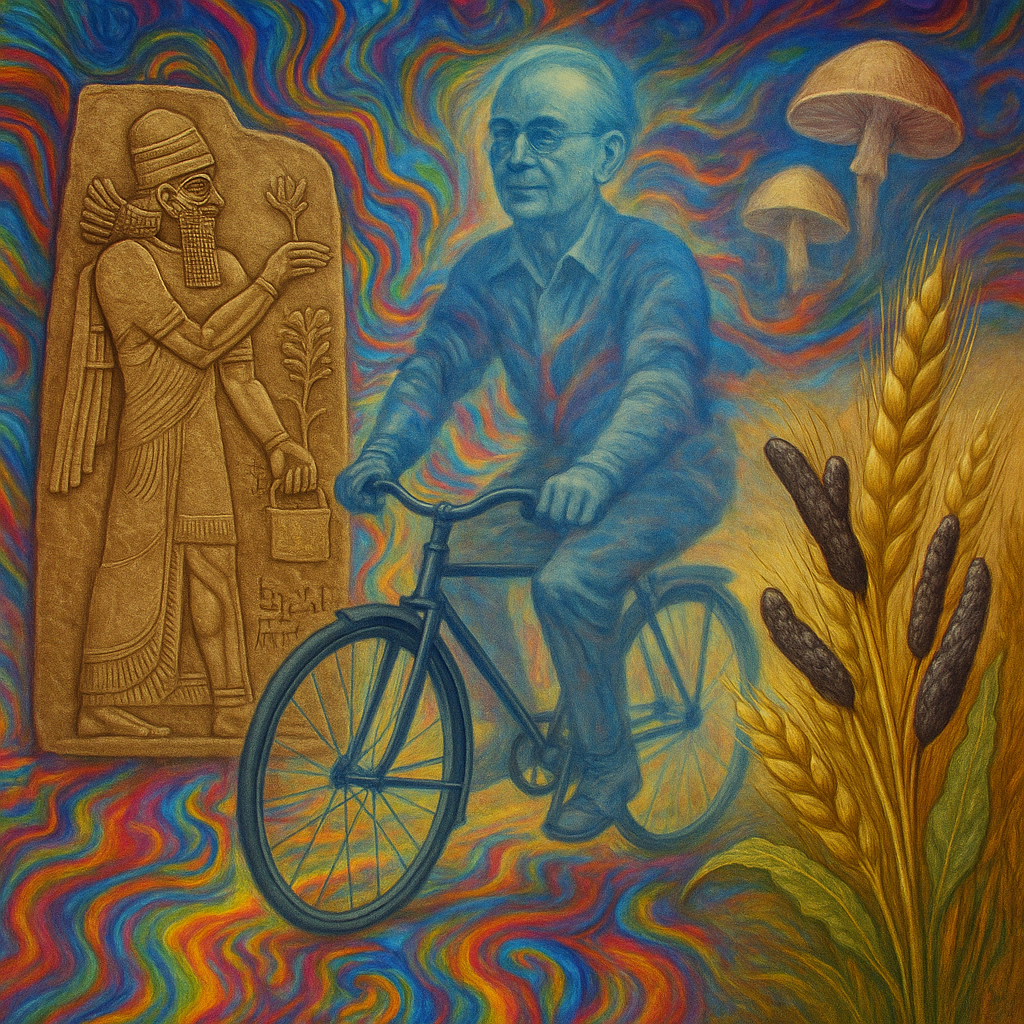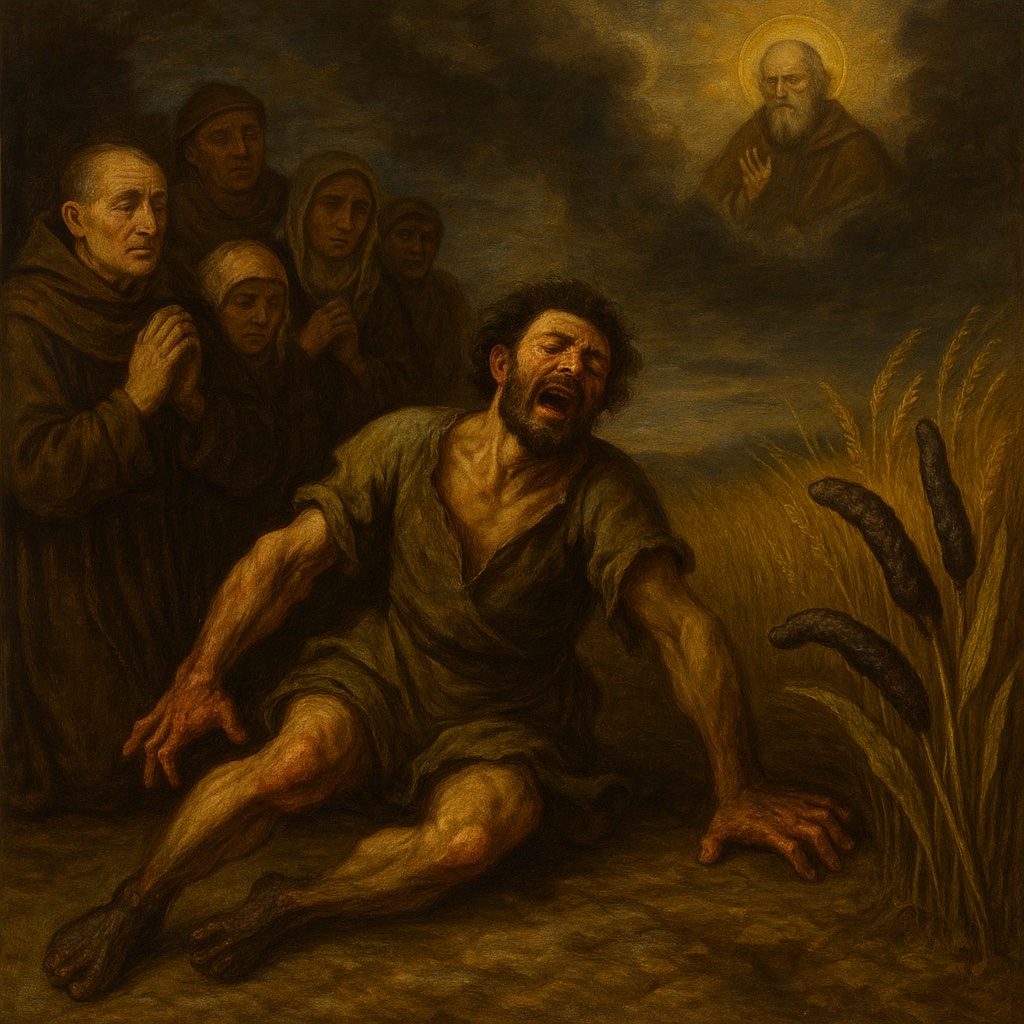LSD A Deeper Dive: Part 1

LSD Deep
Dive Part 1:
This article's purpose is to take you, the reader, on a full quest along the timeline of what we know of today as LSD. Known to our ancestors as a mysterious plague, the hippies as acid, to urban folks as “eight bombs” or “-cid” and to the psychiatrists and scientists as Lysergic acid diethylamide (LSD), one could say that this hallucinogenic has been transcendentally timeless.
The Ancient History
Before it was synthesized into the compounds we know it to be today, we can look beyond our recent human history to as far as 600 BC when the Assyrians first noted the presence of ergot’s effect on the human body. Ergot is a spore form of the Claviceps purpurea fungi. Scientifically speaking “Ergot alkaloids are indole compounds that are biosynthetically derived from L-tryptophan and represent the largest group of fungal nitrogen metabolites found in nature.” The presence of this was also seen throughout ancient Rome (1st century BC) and during European medieval times. One of the earliest recorded pandemics of ergot was in “Annales Xantensen (Germany, 857) with successive pandemics in France, Germany, Scandinavia and the last of ergot poisoning being recorded in Russia in 1927.”

While these were times in history where people unknowingly consumed the fungi through moldy rye bread, there are histories of people or indigenous folks using this wisdom for psychedelic or medicinal uses as well. Research indicates evidence of ergot alkaloids being used precisely for their hallucinatory effects in Greece (2000 BC), in Egypt for hair growth, in Mesopotamia to induce “magic spells,” in China (1100 BCE) in women’s reproductive health and supposedly in other areas for its effect to stop bleeding in birthing women.
Many groups of people throughout old Europe suffered from ergot poisoning and the subsequent painful and unavoidable death. Unknown to them at the time, the ensuing effect of moldy rye bread poisoning was the culprit for what appeared then as a pandemic and name as St. Anthony's Fire or “holy fire.” Looking back through history, this affliction was labeled “ergotism”. The link between these names was due to the symptoms one would experience; a burning sensation within and in the limbs which would eventually begin to fall off, starting with the fingers and toes. These physical symptoms were accompanied by hallucinations and convulsions. It was recorded that hundreds to thousands of people died in those medieval days until they were able to conclude that the disease came from the newly bred moldy rye grain crops.
The name St. Anthony’s Fire arose due to the nature of the hallucinations which appeared similar to those expressed and reported by Saint Anthony during his monastic self-retreat into the Egyptian desert (286 - 305 CE). He reported being attacked by the devil and is known as the founder of Christian monasticism.
Another interesting note on the old-history of this ergot fungus is the suspected interplay it had during the Salem Witch trials of newly formed America. Remember the alkaloids inside of the ergot affect the nervous system and the connecting smooth muscle causing convulsions, vomiting, hallucinations and the deterioration of the body. This gives off a suspiciously sinister or mystical way of suffering for those who didn’t have the science at the time to explain what was happening. For example, the ways in which the body responded in convulsions was given the name; “The Death Dance.” Therefore, certain individuals blamed witches in the area for these sudden outbreaks and used them as evidence to burn many witches during the Salem witch trials.
Recent History (the last 125 years)
Pharmacology
It was in our own recent history in 1938 when we saw this psychedelic energy arise once more. Swiss chemist; Albert Hoffman was experimenting on the ergot fungus and reworking the compounds within the structure of the fungi when he accidentally exposed himself to it. He experienced some odd effects and then later decided to take a microdose which led to a larger than life psychedelic experience (without the dying part). Hoffman then published an article and worked with Sandoz Pharmaceutical company from Switzerland who began distributing it. Even today in 2025, April 19 is known as Bicycle Day which honors the “mind-altering ride” on his bicycle which Hoffman took on his way home the day he first dosed LSD.
LSD reached the United States by 1940 and over the next twenty years LSD became a fascination. Interested in war time advancement the CIA and other governmental divisions explored the different ways LSD could be useful in their endeavors, as well as the ability for it to treat PTSD and alcoholism. Research indicates some heinous experiments and uses by the US Military and CIA during these times on people of the lands which they were in war upon and with soldiers experimenting with the drug as well. Some research indicates a link between some of the misled, negative opinions of an LSD trip due to the associations made between individuals being tortured while also under the influence of LSD (given to them by their military captors).
More in fashion with its psychedelic nature and the trend of psychoanalysis in that same era; it was also heavily experimented with and prescribed to patients. This was done with the agenda to interpret dream states and bring the unconscious world conscious.
Heavily researched during these two decades, scientists and researchers went from publishing 100 articles on LSD in 1951 to publishing over 1000 articles on the same subject by 1961. It became a world wide interest for psychiatrists in particular looking to understand psychosis and mental illness because of the “madenning” or mind bending, hallucinogenic properties of this synthetic drug. One of the earliest prominent psychopharma-cologists Thomas Ban surmised that LSD was responsible for “dragging psychiatry into the modern world.”
The Counter-Culture
The 1960s are also well known for the sweeping adoration of LSD within the creative circles of philosophy, rock & roll & other artists. It was these individuals who paved the way for normal citizens & the youth to begin experimenting with the drug. Leaders in this realm included Cary Grant, Jimmy Hendricks, Jack Nicholson, Anaïs Nin, Aldous Huxley and Ram Das.
Interestingly, spiritual leader and LSD enthusiast Baba Ram Das was the very same; Richard Alpert, a former Harvard faculty member who publicized LSD and its potentialities in expanding consciousness with his co-worker Timothy Leary.
The Mother of Mushrooms
LSD has an interwoven history with psychedelic mushrooms as well. In 1955, R. Gordon Wasson, a New York banking executive, traveled to Mexico searching for his own chance to “meet God” and was introduced to Maria Sabina. Maria was a non-spanish speaking, indigenous woman from the Sierra Mazateca area of Oaxaca, Mexico had become a well known healer in her village in the thirty years prior. She worked with locals hoping to heal illnesses through a velada (aka ceremonies with psilocybin mushrooms). She called these mushrooms the “Holy Children.”
After Wasson returned from his own psychedelic journey, he wrote and published an article “Seeking the Magic Mushroom” in 1957. It went viral and due to Maria's identity not being protected in his publications there was a large fallout upon Maria and her village. Stories on this record indicate she was blamed for the fallout on their sacred cultural and otherwise, undisturbed peace. This is a common story of what happens when otherwise undisturbed indigenous communities interface with colonialized, industrialized folks.
Therefore, it is due and just that Maria be included in the conversation on psychedelics. It was her sacred devotion to psychedelic mushrooms that led Wasson to return to Mexico for seven additional psychedelic ceremonies. His reports got the attention of chemist Hoffman, who eventually also began working with psychedelic mushrooms (as he did with LSD); adding momentum behind the psychedelic revolution of the 1950’s and 60’s.
Works Cited
Bragagnolo, Caterina. “Maria Sabina - the Story of the Priestess of Mushrooms.” Womenonpsychedelics.com, 8 Mar. 2023, www.womenonpsychedelics.com/post/maria-sabina-the-story-of-the-priestess-of-mushrooms. Accessed 15 Apr. 2025.
Carlton, Genevieve . “A Medieval Outbreak Gave People Nightmare Hallucinations and Caused Their Limbs to Fall Off.” Ranker, 23 Sept. 2021, www.ranker.com/list/ergot-medieval-outbreak/genevieve-carlton. Accessed 3AD.
Dyck, Erika. “The History of LSD - the Original Psychedelic Drug: Acid Trip.” ResearchGate, Portland Press, Apr. 2007, www.researchgate.net/publication/288794607_The_history_of_LSD_-_The_original_psychedelic_drug_Acid_trip.
Hofmann, Albert. “LSD: My Problem Child.” The Antioch Review, vol. 39, no. 3, 1981, p. 389, maps.org/images/pdf/books/lsdmyproblemchild.pdf, https://doi.org/10.2307/4638477. Accessed 15 Apr. 2025.
Jastrzębski, Michał K., et al. “Methods of Lysergic Acid Synthesis—the Key Ergot Alkaloid.” Molecules, vol. 27, no. 21, 28 Oct. 2022, p. 7322, www.ncbi.nlm.nih.gov/pmc/articles/PMC9654825/, https://doi.org/10.3390/molecules27217322.
MacLean, Katherine. “Psychedelic Women.” Katherine MacLean, PhD, 2025, www.katherinemaclean.org/psychedelic-women. Accessed 15 Apr. 2025.
Massari, Paul. “A Long, Strange Trip | Graduate School of Arts and Sciences.” Gsas.harvard.edu, 28 July 2021, gsas.harvard.edu/news/long-strange-trip.
Noble, Lucy . “Saint Anthony’s Fire and Brimstone: Daily Bread or Daily Dread? – the Mills Archive.” Millsarchive.org, 25 June 2020, new.millsarchive.org/2020/06/25/saint-anthonys-fire-and-brimstone-daily-bread-or-daily-dread/. Accessed 15 Apr. 2025.
NPR. “Bicycle Day Marks an Unofficial Commemoration of the First Use of LSD.” NPR, 19 Apr. 2024, www.npr.org/2024/04/19/1245810413/bicycle-day-marks-an-unofficial-commemoration-of-the-first-use-of-lsd.
Sproul, Conrad . ““Don’t Kill My Buzz, Man!” - Explaining the Criminalization of Psychedelic Drugs.” Oregon Undergraduate Research Journal, vol. 19, no. 1, 2021, pp. 1–53, scholarsbank.uoregon.edu/server/api/core/bitstreams/bef3eed4-81e9-4cdd-a51f-65d0f5261950/content. Accessed 15 Apr. 2025.
ISSN: 2160-617X.
Researched and Authored by Maeve Lee at ThisModernMystic.com